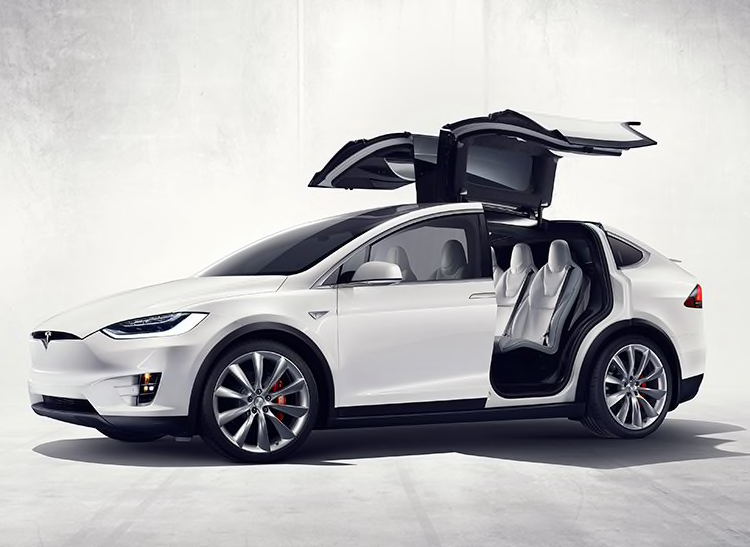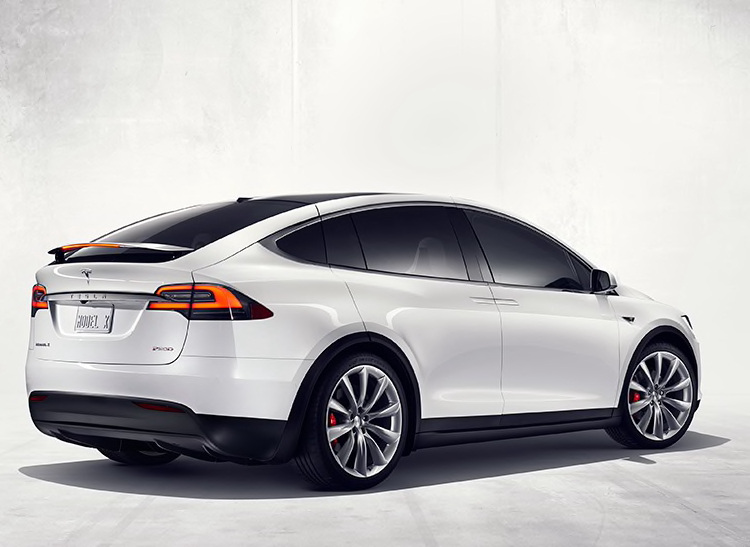Tesla Motors has unveiled the much-anticipated Tesla Model X, the crossover iteration of its Model S with notable safety innovations and falcon-wing second-row doors. At an Apple-like California event last night, Founder and CEO Elon Musk also handed out keys to the first Model X owners.
The Tesla Model X is essentially the Model S hatchback molded into a sleek crossover, carrying with it the latest, most potent electric powertrain and advanced safety features, then adding a few new touches.
The Model X costs about $5,000 more than comparable Model S versions due to the greater size and body complexity, putting starting prices at about $80,000. Like most new-car roll outs, the Tesla Model X production will initially focus on top-end versions. In this case, Tesla is initially selling versions with a massive 90-kWh battery pack.
The company eventually has plans to go more mass market with the Model 3 compact sedan—which is targeted for 2018 and should cost close to $35,000—but the pricing on the Model X will definitely keep this vehicle out of reach for most consumers.
The Model S P85D was the top scorer for performance in our road test, but the reliability of the Model S line is still a big question. We'll have updated data on that front soon.
Despite the larger heft, tipping the scales at 5,441 lbs., the Tesla Model X promises efficiency close to that of the Model S. The P90 has been given an estimated 257-mile range rating by the EPA, with energy consumption rated at 92 mpg equivalent.
Like the Model S, the Tesla Model X promises high-level performance—especially for an SUV. The 90D version has a claimed 0-60 mph time of 4.8 seconds, with the 762-hp P90D version boasting 3.8 seconds. Upgrade to Ludicrous, a mode for maximum acceleration, and that time is reportedly shaved to 3.2 seconds. (Sources for data below are the EPA and Tesla Motors.)
| Tesla | Model X 90D | Model X P90D | Model S P85D | Model S 85D | Model S 70D |
|---|---|---|---|---|---|
| Range, miles | 257 | 250 | 253 | 270 | 240 |
| MPGe, combined | 92 | 89 | 93 | 100 | 101 |
| 0-60 mph, sec. | 4.8 | 3.8 | 3.1 | 4.2 | 5.2 |

Safety Features
Musk says that the Model X was designed with an emphasis on safety, declaring an expectation that it will earn five-star ratings in every government test, including front crash, side pole, and rollover. Aiding its safety performance is not only a strong structure, fortified with the large, low-mounted battery pack, but also an inherent benefit of being an electric vehicle—no engine to be pushed back into the passenger compartment.
The Tesla Model X comes standard with advanced safety features, including high-speed automatic braking and a side-collision-avoidance system that will use the camera, radar, and ultrasonic sensors to monitor traffic all around it. Tesla emphasizes that its over-the-air updates will continue to improve the "autopilot" features, edging the Model X (and Model S) closer to autonomous operation.
This sort of proactive safety technology is advanced even for the luxury vehicle segment, but these types of innovations have been moving quickly into more mainstream vehicles.
Presented as an air quality safety element, Musk showcased the massive HEPA air filter that the Tesla Model X uses to clean the interior air for occupants. Common air filters are about the size of a paperback book; the Tesla filter is scaled more like a car radiator, with about tenfold greater surface area. And it is backed by a secondary air filter. This filter system is configured to not just remove smog, allergens, and bacteria, but it can also scrub ammonia, viruses, hydrocarbons, and sulfur. Musk joked that the Tesla Model X might be just the vehicle for surviving an apocalyptic outbreak—complete with a bio-weapon defense mode.

Doors That Pay Attention to You
On the Model S, the retracted handles emerge from the doors with just a light touch to allow entry—although that doesn't always work as planned. The Model X goes a step further by sensing the driver approaching and opening the driver's door, then closing it once the driver is seated. This feature looks to avoid any awkward delay experienced with the Model S door handles.
The most distinguishing feature of the Tesla Model X is its falcon-wing doors that swing upward to expose a giant aperture and allow minivan-like access to the second row.
Falcon-wing doors open high enough that a tall adult can walk under them without ducking, which is presented as being particularly convenient for assisting children in getting buckled in. The second-row seats motor forward to allow access to the third row.
Because of how they articulate on two sets of hinges, the falcon-wing doors can open in tight spaces. Tesla demonstrated this ability with a Model X flanked by two vehicles so close together that it would be difficult to walk between them. In a garage, the X senses ceiling height and side obstacles, then moves accordingly to avoid scratching.
There are some clever uses of space, beyond the "frunk" storage under the hood. For instance, the center console features a smartphone holster that is compatible with all phones, allowing a simple "drop and charge" action. There is room under the second-row seats for storage, with space for a laptop bag or backpack.
And if you need even more cargo-toting ability, the Model X can tow 5,000 lbs. while transporting seven people. A roof rack would be impossible with these doors but there is an available accessories hitch for bikes, skis, and snowboards that clicks on in seconds and still allows the rear hatch to open.
Tesla is taking orders for the Model X, with the delivery for new reservations expected in the latter half of 2016. Consumer Reports placed its order three years ago, and we will be begin testing this winter once it joins our fleet.

















